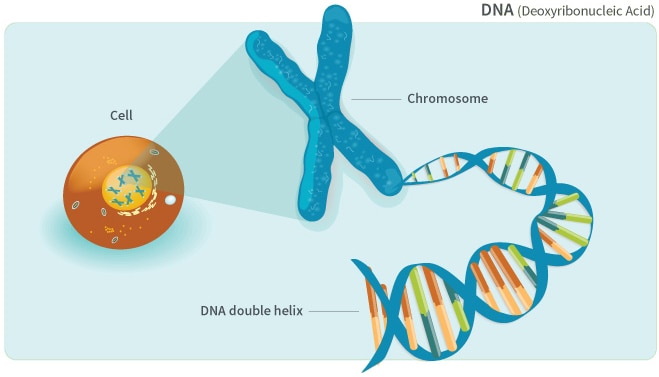Where is DNA found?
You have around 30 trillion cells in your body, and DNA is found in most but not all of them. For example, mature red blood cells don't have any DNA. Also, some mature hair, skin, and nail cells don't have any DNA either.
 The DNA isn't just floating around in the cell. Most of it is stored in a small compartment in the cell called the nucleus. A small bit of it can also be found in another compartment called the mitochondrion.
The DNA isn't just floating around in the cell. Most of it is stored in a small compartment in the cell called the nucleus. A small bit of it can also be found in another compartment called the mitochondrion.
Each human cell has about six picograms (pg) of DNA. This is a tiny amount and is much smaller than a grain of rice, which typically weighs about 29 billion picograms—that's 29,000,000,000 picograms.
Where Is DNA Located in Other Organisms?
Where DNA is located depends on the type of organism. If you are a prokaryote like a bacterium or an archaebacterium, then your DNA is stored in the cytoplasm of the cell. For prokaryotes, the cytoplasm is basically everything inside of a cell.
The situation is different if you are a eukaryote like a plant, animal, fungus, or a variety of microscopic beasts that aren't prokaryotes (and if you are reading this you are almost certainly human and thus a eukaryote). While these still have cytoplasm, they also have membrane-bound organelles that act as little compartments where different activities can happen in the cell.
Most of a eukaryote's DNA is stored in one of these organelles called the nucleus. A bit of eukaryotic DNA can also be found in two other organelles: mitochondria and—for organisms that can photosynthesize—chloroplasts.
DNA Can Be Found in Which Three Organelles?
As described above, DNA can be found in three organelles: the nucleus, mitochondrion, and chloroplast. Only eukaryotes have a nucleus, which is a large structure that's surrounded by a membrane. Nuclear DNA comes in the form of long, linear pieces of DNA called chromosomes. Humans have over six feet of DNA typically spread out over 46 chromosomes.
Most eukaryotes also have mitochondria, which are the energy powerhouse of the cell. In mitochondria, the DNA is called mitochondrial DNA (mtDNA) and instead of being linear, it is circular. Mitochondria usually have only a small fraction of the DNA that is found in the nucleus.
Only plants and eukaryotic algae have chloroplasts. These organelles can capture sunlight and turn it into energy in a process called photosynthesis. In chloroplasts, the DNA is called chloroplast DNA (cpDNA), and like the DNA in mitochondria, it's circular.
How Is DNA Stored Inside Your Cells?
DNA is packed tightly in the nucleus of your cells as chromosomes. A chromosome is a thread-like structure that has DNA coiled around proteins called histones. Humans are 'diploid' organisms, which means they have two copies of each chromosome—one from mom and one from dad. People typically have 23 pairs of chromosomes for a total of 46.
If you were to unwind the DNA in one cell, it would be six feet long. Combining the DNA from all your cells would make a strand that's 34 billion miles long. For comparison, at its farthest, Pluto is only 4.67 billion miles away from Earth.
In other words, the DNA from just one human is so long that it could reach to Pluto and back more than seven times. Now you can see why it's so important to pack that DNA tightly into that microscopic cell.